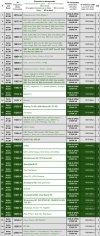Chatting to my neighbour today and he mentioned that on his Freesat system (Humax box, 4-5 yo, but don't know which exactly) he can't watch Dave and a few other minor channels because they report weak or low signal. Been happening for a couple of years.
I'm puzzled as I thought all the channels were on the one big 'stream', unlike Freeview where there are different frequencies and powers used for each mux.
Any ideas on this?
I'm puzzled as I thought all the channels were on the one big 'stream', unlike Freeview where there are different frequencies and powers used for each mux.
Any ideas on this?



